#api platform in banking
Explore tagged Tumblr posts
Text

"Elevating Banking with Seamless API Integration"
Banking API Integration is the Seamlessly integrate APIs for efficient operations, exceptional customer experiences, and innovative financial services, propelling the industry to new heights.
#bank api integration#open api banking#api banking platform#api platform in banking#open banking api platform#api based banking#best open banking apis
0 notes
Text
Archana Joshi, Head – Strategy (BFS and EnterpriseAI), LTIMindtree – Interview Series
New Post has been published on https://thedigitalinsider.com/archana-joshi-head-strategy-bfs-and-enterpriseai-ltimindtree-interview-series/
Archana Joshi, Head – Strategy (BFS and EnterpriseAI), LTIMindtree – Interview Series
Archana Joshi brings over 24 years of experience in the IT services industry, with expertise in AI (including generative AI), Agile and DevOps methodologies, and green software initiatives. She currently leads growth strategies and market positioning for the Enterprise AI service line and the Banking and Financial Services Business Unit at LTIMindtree. Joshi has worked with Fortune 100 clients across various geographies and is a regular speaker at industry forums and events.
LTIMindtree is a global technology consulting and digital solutions company that works with enterprises across various industries to support business model evolution, innovation, and growth through digital technologies. Serving over 700 clients, LTIMindtree provides domain and technology expertise aimed at enhancing competitive differentiation, customer experiences, and business outcomes in an increasingly interconnected world.
Given your extensive experience in transforming IT services across various organizations, how has your personal leadership style evolved at LTIMindtree, particularly in driving the adoption of Generative AI?
With over two decades of experience in IT Services, I have dedicated my career to driving transformative technology solutions for customers, be it Agile/DevOps or generative AI (GenAI). At LTIMindtree, my focus is on empowering organizations to leverage GenAI for strategizing and executing their digital transformation journeys. I prioritize customer-centric strategies, working closely with clients to understand their unique challenges and deliver tailored AI solutions that drive business value. As the head of strategy, I need to collaborate with teams across various departments to promote GenAI adoption and stay informed about new developments to guide my decisions. GenAI processes vast amounts of data to provide actionable insights. This capability is particularly beneficial for a data-oriented leader like me, who values evidence-based strategies.
For example, every morning when I start my day with GenAI-based copilots to help me understand the top items that need my attention or provide insights to create reports that I can share with my team on adoption. In fact, I often say within the team that GenAI-based copilots have essentially become integral members of our team, much like trusted wingmen. They support us by providing valuable insights, automating tasks and keeping us aligned with our strategic goals.
How is Generative AI reshaping traditional IT service models, particularly in industries that have been slower to adopt digital transformation?
GenAI is revolutionizing traditional IT service models across all industries by significantly enhancing IT developer productivity. From co-pilots that generate code to synthetic data for testing and automating IT operations, every facet of IT is being transformed. Consequently, the focus of IT service models is shifting from cost-driven to efficiency- and impact-driven approaches. This means that the value of IT services is now measured by their ability to deliver tangible outcomes rather than just cost savings. This shift is also leading to new types of work in IT services, such as developing custom models, data engineering for AI needs and implementing responsible AI.
Just 18 months ago, these services were not the norm. Even in heavily regulated industries like healthcare and financial services, where legacy systems are prevalent, the value of GenAI in improving operational efficiency is increasingly recognized.
Our own research at LTIMindtree, titled “The State of Generative AI Adoption,” clearly highlights these trends. In healthcare, we’re seeing GenAI make a big impact by automating things like medical diagnostics, data analysis and administrative work. This is helping doctors and healthcare providers make quicker, more accurate decisions—though adoption remains cautious due to strict compliance and regulatory frameworks. In financial services, GenAI enhances risk management, fraud detection and customer service by automating manual tasks. However, the sector’s adoption is driven by concerns around risk, governance and sensitive data.
Can you share specific examples of how LTIMindtree has successfully integrated GenAI into traditional IT workflows to drive efficiency and innovation?
At LTIMindtree, we have a 3-pronged strategy towards AI. The philosophy of “AI in Everything, Everything for AI, AI for Everyone” underscores our commitment to integrating AI across all facets of our operations and services. This approach ensures that AI is not just an add-on but a core component of our solutions, driving innovation and efficiency.
Customers are looking at AI to improve efficiency across the board. From reducing hours spent on repetitive, time-consuming tasks to scaling operations and improving the reliability of business processes, AI is becoming a core part of their strategy. Our engineers are focused on integrating AI copilots into their workflows, covering everything from coding, testing, and deployment to software maintenance.
For example, in a transformational move for a Fortune 200 company, we’ve employed GenAI-based copilots to convert large stored procedures into Java, enabling their modernization journey. We recently worked with a large insurance company that wanted to automate its data extraction processes. They were facing scalability and accuracy issues with their manual approach. So, our team developed a companion bot, which now helps process multiple documents, extracting critical information like risk, eligibility, coverage and pricing details. This has significantly reduced the time it takes them to file product offers and manage various coverages.
With the rapid adoption of GenAI across various sectors, what are some of the ethical considerations enterprises should be mindful of, and how does LTIMindtree ensure responsible AI use?
The evolution of AI is promising but also brings many corporate challenges, especially around ethical considerations in how we implement it.
At LTIMindtree, we have an AI council comprising cross-functional experts from AI, security, legal, data privacy, and various industry verticals. This council has established AI assurance frameworks and collaborates with industry bodies on AI regulatory guidelines. Additionally, it works with teams implementing AI to validate their ethical risk postures.
To effectively implement GenAI, we have established a set of core ethical principles aligned with corporate values, addressing fairness, accountability, transparency and privacy. This requires executive sponsorship and support from legal and security teams. Next, technical interventions are incorporated into our internal processes that focus on high-quality, unbiased data, with measures to ensure data integrity and fairness. Fostering an ethical AI culture involves continuous training on AI capabilities and potential pitfalls, such as AI hallucinations. Finally, regular audits and updates of AI systems are done to address vulnerabilities and ensure the accuracy of AI outputs. This comprehensive approach ensures that GenAI is implemented responsibly and effectively, driving business value while maintaining ethical standards.
How does LTIMindtree’s AI platform address concerns around AI ethics, security, and sustainability?
As we continue to roll out new AI tools and platforms, we must ensure they meet our standards and regulations around the technology’s use. In addition to maintaining data quality to provide accurate and unbiased outputs, we are committed to meeting high standards for security and sustainability.
Our platform is built around the principles of responsible and mindful AI. In terms of sustainability, we are aware of the growing energy demand required to support AI models, from training to its continued operation. We have adopted a reduce, reuse and recycle approach to AI to address the carbon footprint and the importance of creating environmentally friendly and sustainable AI practices. Through this process, we focus on reducing the parameters by focusing on smaller, more specific large language models (LLMs) that can efficiently address the needs of enterprise applications while creating a smaller carbon footprint. Additionally, we repurpose data for various applications and use cases to avoid redundancies and reuse mechanisms and prompts that can be used for similar tasks to promote efficiency and sustainability. We are also looking at quantized models to reduce memory footprint, receive faster inference, reduce cost and build sustainable applications.
As I mentioned earlier, security is a key concern with the use of any AI tool or application. At LTIMindtree, we have not only prioritized data security and fair usage, but we have made it a cornerstone of our AI strategy. We have also incorporated 50+ best-in-class moderation APIs and responsible AI frameworks from third party providers like the Nvidia Nemo guardrails and the IBM Watson Governance models. Our platform efficiently manages data while factoring in privacy, security, ethical use and sustainability by leveraging sound governance measures and a well-built framework.
How is GenAI influencing Agile project management at LTIMindtree? What advantages does it bring to Agile teams, and are there any trade-offs?
Integrating GenAI into Agile practices is transforming how teams work. It boosts productivity, streamlines processes, and opens new avenues for innovation. As the software development landscape evolves, we are leveraging GenAI to automate those repetitive tasks that can bog teams down. This shift allows them to focus more on creative problem-solving and innovation—exactly where they should be.
When we start integrating GenAI into Agile frameworks, there are a few key points we would like to emphasize. First, it is important to understand the nature of AI tools and their potential impact on team collaboration. For instance, Agile teams need to be mindful of the limitations of these tools. They rely on pre-existing data rather than providing real-time insights, so it is essential to validate and refine their outputs.
Our AI native DevOps leverages cutting-edge technology like knowledge graphs, custom SLMs (small language models) along with software development lifecycle (SDLC) agents. This has the potential to achieve 35-50% efficiency in productivity across the Agile-DevOps cycle for an enterprise. It helps an Agile pod during user story creation, sprint planning, code generation to the CI/CD pipelines and subsequent incident management.
With AI transforming the IT industry, how is LTIMindtree addressing the need for new talent and skill sets? What initiatives have you led to ensure your teams are equipped for the AI-driven future?
The rise of innovative technologies in the IT industry has highlighted a gap between the skills our workforce currently has and what is needed to thrive in an AI-driven world. GenAI has the potential to completely reshape the daily roles of many employees, so preparing for new skills and roles is essential.
At LTIMindtree, we are taking the lead in this transformation by focusing on upskilling our employees to meet these emerging demands. We have our GARUDA initiative, specifically designed for training and onboarding teams in GenAI and enterprise AI. We recognize that effective training and educational resources are crucial, and we are committed to creating a culture of continuous learning.
Our training strategies include data-driven adaptations, real-time online learning, advanced reinforcement learning, transfer learning and feedback loops. This way, we ensure that our teams are not just keeping pace with change but are genuinely equipped to excel in their evolving roles. It is an exciting time, and we are all on this journey together.
In addition to this, we have tied up with seven academic institutions to equip future talent on AI skills. Here we are involved right from curriculum design to administering the curriculum, as well as equipping the professors via train-the-trainer approaches.
How do you see the role of human talent evolving in an increasingly AI-driven workplace, and what steps are you taking to prepare your workforce for this shift?
In the past, there were distinct roles for creative individuals and technology experts. However, there’s a noticeable shift towards adopting, mainstreaming and scaling innovative content creation techniques, blurring the lines between creativity and technology. This integration is impacting various industries, where the conventional separation between creative roles and technology jobs is gradually diminishing. While promising, this evolution comes with its challenges that indicates a substantial shift of focus on reskilling as an essential for capitalizing on AI’s benefits.
The big conversation now is how to make this GenAI change stick and scale. Here’s where change management becomes crucial. It requires a structured approach and a dedicated team to oversee the AI adoption process. People, not just technology, are at the heart of successful GenAI adoption. It can be a powerful tool for empowerment, even among those who initially perceive it as a threat. Forrester forecasts that by 2030, only 1.5% of jobs will be lost to GenAI, while 6.9% will be influenced by it. Therefore, leaders must prioritize transparency and motivate their workforce about the future of AI in the workplace.
AI is changing job roles across the IT sector, automating everyday tasks, and placing emphasis on strategic decision-making and complex problem-solving. At LTIMindtree, we believe this is a mindset shift and hence have established a dedicated central initiative GARUDA – that focuses on this change adoption. The GARUDA initiative is not just about role-based training and upskilling but also on creating AI ambassadors that can drive this adoption across various layers. We are also working with our HR function to look at impacts on various roles within the organization, along with their career paths and associated rewards and recognition. Today at LTIMindtree we have three levels of upskilling pathways – foundation, practitioner and expert. Over 50,000 of our associates have already completed the foundational skilling initiatives that include concepts of AI to the usage of copilots as well as responsible AI considerations.
What are some of the most innovative GenAI applications you’ve seen recently, and where do you see the technology headed in the next 3-5 years?
We are just scratching the surface of what GenAI can do, and I am thrilled about its potential across the IT industry and beyond. As more sectors jump on board, I find myself particularly excited about their applications to transform human lives.
At LTIMindtree, we have partnered with the UN Refugee Agency to enhance its crisis response capabilities using GenAI. This collaboration aims to accelerate on-the-ground crisis response, providing timely aid and support to refugees in need. The innovative use of technology helps bring hope and relief to vulnerable populations during their greatest times of need. For an American life insurance company, we developed a GenAI solution that translates spoken words in real-time, significantly improving the customer experience. By bridging communication gaps, this technology fosters better understanding and connection between people, bringing us closer together and ensuring that language barriers no longer hinder effective experiences.
Looking ahead, Agentic AI will enable autonomous task performance and decision-making. By 2027, industry-specific models will dominate, synthetic data use will rise, and energy-efficient implementations will grow. Multimodal models integrating text, image, audio and video inputs will enhance capabilities, driving significant economic impact and innovation. GenAI is poised to add up to $4.4 trillion to the global economy annually, revolutionizing industries and driving efficiency and sustainability, retail, healthcare and life sciences.
The reality is that every workplace will be touched by GenAI in some capacity, becoming a part of our everyday operations. As we continue this transition, I cannot wait to see how it evolves and what innovations will come next.
#000#ADD#add-on#adoption#Agentic AI#agents#agile#agile project management#ai#AI adoption#AI Ethics#AI hallucinations#AI models#ai platform#ai skills#AI strategy#AI systems#ai tools#American#Analysis#APIs#applications#approach#attention#audio#autonomous#banking#BFS#board#bot
0 notes
Text
Explore the best developer friendly API platforms designed to streamline integration, foster innovation, and accelerate development for seamless user experiences.
Developer Friendly Api Platform
#Developer Friendly Api Platform#Consumer Driven Banking#Competitive Market Advantage Through Data#Banking Data Aggregation Services#Advanced Security Architecture#Adr Open Banking#Accredited Data Recipient
0 notes
Text
#video kyc solution providers#video kyc platform#video kyc providers#video kyc services#KYC UK#kyc solution#kyc api#fintech#banks#finance#kyc companies#banking
1 note
·
View note
Text
0 notes
Text
Empowering Consumers with API-Driven Banking: Enhancing Customer Experiences

The FinTech ecosystem is dynamic at its best, and in the high-octane banking landscape, API-powered innovations are emerging as a transformative force. The modern consumer has become more aware than ever, and APIs are revolutionizing how consumers manage their finances and interact with financial institutions. Read more info. please visit here - https://sites.google.com/view/api-driven-banking/
0 notes
Text
#kyc canada#kyc providers#kyc solution#kyc api#kyc software#fintech#kyc platform#healthcare#insurance#kyc verification#KYC Solutions for Canada#business#finance#banks#blockchain#crypto
1 note
·
View note
Text
2024 team sponsors recap!
this is completely irrelevant to F1 but i study and do these stuffs for a living sooo 😩😩 2023 sponsors are based on the sponsors that are there at the beginning of the season (new sponsors that join in the middle of the season will be classified as 2024's)
Mercedes AMG Petronas F1 Team:
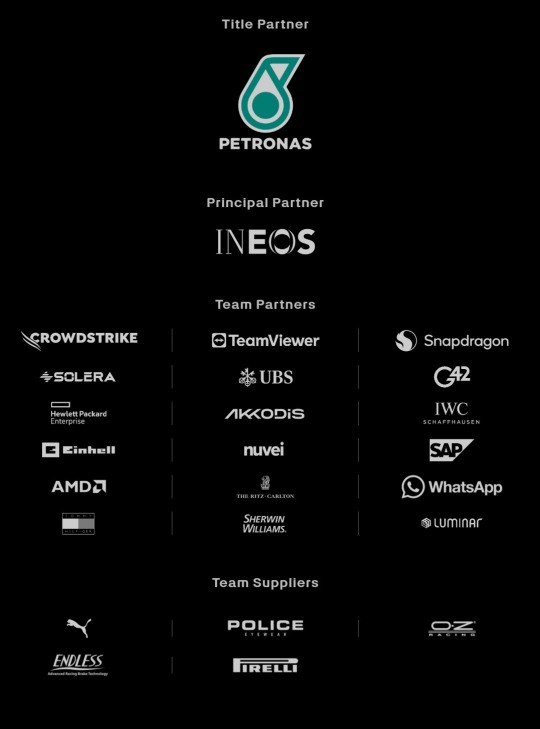
New sponsors: Whatsapp, Luminar (American tech company), SAP (German software company), nuvei (Canadian credit card services), Sherwin Williams (American painting company) 2024 data last update: 2024/02/14
Old sponsors that left: Monster Energy, Pure Storage (American technology company), fastly (American cloud computing services), Axalta (American painting company), Eight sleep (American mattresses company) 2023 data last update: 2023/01/07
Oracle Red Bull Racing F1 Team:
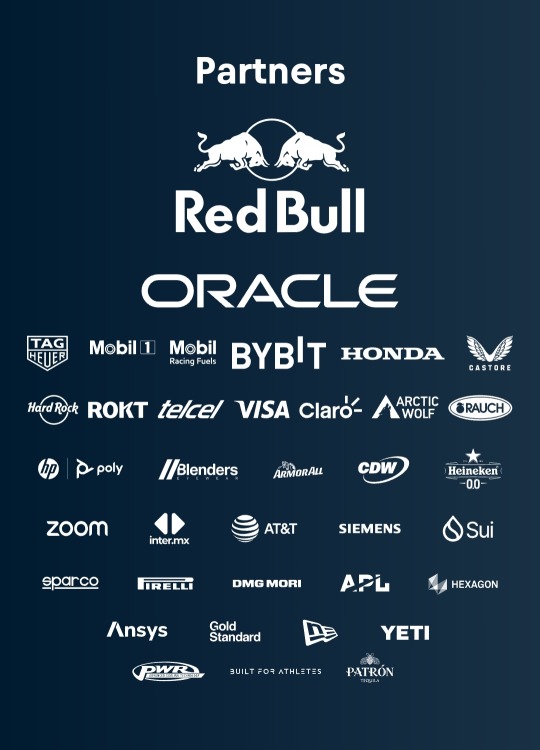
New sponsors: Yeti (American cooler manufacturer, joined later in 2023), APL (American footwear/athletic apparel manufacturer, joined later in 2023), CDW (American IT company, joined later in 2023), Sui (American tech app by Mysten Labs, joined later in 2023), Patron Tequila (Mexican alcoholic beverages company, joined later in 2023) 2024 data last update: 2024/02/15
Old sponsors that left: CashApp, Walmart, Therabody (American wellness technology company), Ocean Bottle (Norwegian reusable bottle manufacturer), PokerStars (Costa Rican gambling site), Alpha Tauri (? no info if they're official partners or not but Austrian clothing company made by Red Bull), BMC (Switzerland bicycle/cycling manufacturer), Esso (American fuel company, subsidiary of ExxonMobil), Hewlett Packard Enterprise (American technology company) 2023 data last update: 2023/03/07
More: Esso is a subsidiary of Mobil so there's possibility they merged or something
Scuderia Ferrari:
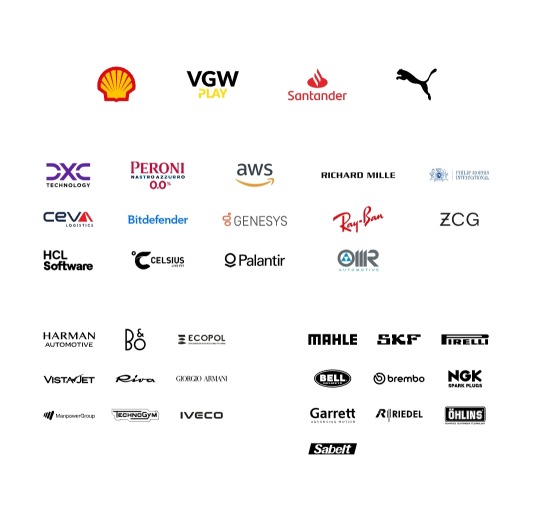
New sponsors: VGW Play (Australian tech game company, joined later in 2023), DXC Technology (American IT company, joined later in 2023), Peroni (Italian brewing company), Z Capital Group/ZCG (American private asset management/merchant bank company), Celsius (Swedish energy drink manufacturer) 2024 data last update: 2024/02/15
Old sponsors that left: Mission Winnow (American content lab by Phillip Morris International aka Marlboro), Estrella Garcia (Spanish alcoholic beverages manufacturer), Frecciarossa (Italian high speed train company) 2023 data last update: 2023/02/16
More: Mission Winnow is a part of Phillip Morris International. They are no longer listed as team sponsor but PMI is listed instead.
(starting here, 2023 data last update is 2023/02/23 and 2024 data last update is 2024/02/15)
McLaren F1 Team: (Only McLaren RACING's data is available idk if some of these are XE/FE team partners but anw..)
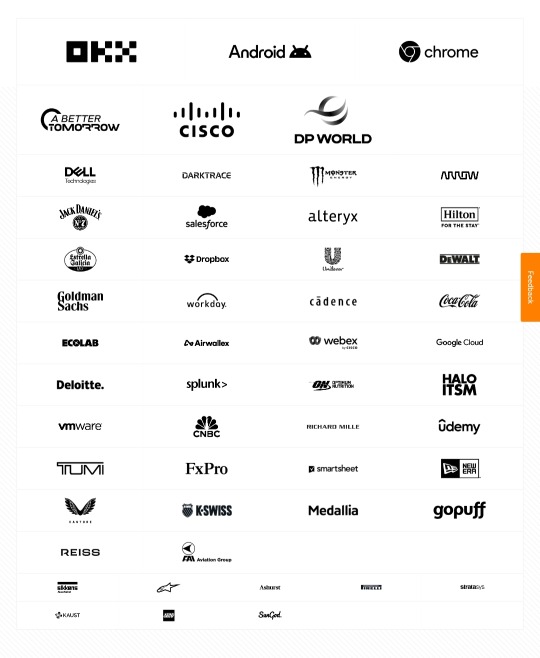
New sponsors: Monster Energy, Salesforce (American cloud based software company, joined later in 2023), Estrella Garcia (Spanish alcoholic beverages manufacturer), Dropbox (American file hosting company), Workday (American system software company, joined later in 2023), Ecolab (American water purification/hygiene company), Airwallex (Australian financial tech company), Optimum Nutrition (American nutritional supplement manufacturer), Halo ITSM (American software company, joined later in 2023), Udemy (American educational tech company, joined later in 2023), New Era (American cap manufacturer, joined in 2023), K-Swiss (American shoes manufacturer, joined later in 2023), Alpinestars (Italian motorsports safety equipment manufacturer)
Old sponsors that left: DP World (Emirati logistics company), EasyPost (American shipping API company), Immersive Labs (UK cybersecurity training company?), Logitech, Mind (UK mental health charity), PartyCasino (UK? online casino site), PartyPoker (American? gambling site), Sparco (Italian auto part & accessory manufacturer), Tezos (Switzerland crypto company)
Aston Martin Aramco F1 Team:

New sponsors: Valvoline (American retail automotives service company, joined later in 2023), NexGen (Canadian sustainable? fuel company), Banco Master (Brazilian digital banking platform, joined later in 2023), ServiceNow (American software company, joined later in 2023), Regent Seven Seas Cruise, Wolfgang Puck (Austrian-American chef and restaurant owner, joined later in 2023), Financial Times (British business newspaper), OMP (Italian racing safety equipment manufacturer), stichd (Netherlands fashion & apparel manufacturer)
Old sponsors that left: Alpinestars (Italian motorsports safety equipment manufacturer), crypto.com (Singaporean cryptocurrency company), ebb3 (UK? software company), Pelmark (UK fashion and apparel manufacturer), Peroni (Italian brewing company), Porto Seguro (Brazilian insurance company), Socios (Malta's blockchain-based platform), XP (Brazilian investment company)
Stake F1 Team (prev. Alfa Romeo):
???? Can't found their website (might be geoblocked in my country???)
BWT Alpine F1 Team:

New sponsors: MNTN (American software company), H. Moser & Cie (Switzerland watch manufacturer), Amazon Music
Old sponsors that left: Bell & Ross (French watch company), Ecowatt (??? afaik French less-energy smthn smthn company), Elysium (French? American? Software company), KX (UK software company), Plug (American electrical equipment manufacturing company)
Visa CashApp RB F1 Team (prev. Scuderia Alpha Tauri):
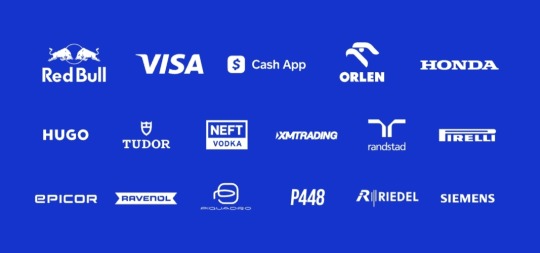
New Sponsors: Visa, CashApp, Hugo Boss, Tudor, Neft Vodka (Austrian alcoholic beverages company), Piquadro (Italian luxury bag manufacturer)
Old sponsors that left: Buzz (?), Carl Friedrik (UK travel goods manufacturer), Flex Box (Hongkong? shipping containers manufacturer), GMG (Emirati global wellbeing company), RapidAPI (American API company)
Haas F1 Team:

New sponsors: New Era (American cap manufacturer, joined later in 2023)
Old sponsors that left: Hantec Markets (Hongkong capital markets company), OpenSea (American NFT/Crypto company)
Williams Racing:


New sponsors: Komatsu, MyProtein (British bodybuilding supplement), Kraken (American crypto company, joined later in 2023), VAST Data (American tech company), Ingenuity Commerce (UK e-commerce platform), Puma (joined later in 2023)
Old sponsors that left: Acronis (Swiss software company), Bremont (British watch manufacturer), Dtex Systems (American? cybersecurity company), Financial Times (British business newspaper), Jumeirah Hotels & Resorts, KX (UK software company), OMP (Italian racing safety equipment manufacturer), PPG (American painting manufacturer), Umbro (English sports equipment manufacturer), Zeiss (German opticals/optometrics manufacturing company)
#mercedes amg petronas#red bull racing#scuderia ferrari#visa cash app rb#haas f1 team#mclaren f1#aston martin#alpine f1#williams racing#stake f1 team#f1#ari's rant#sponsor talks
42 notes
·
View notes
Note
Hi! I’m a student currently learning computer science in college and would love it if you had any advice for a cool personal project to do? Thanks!
Personal Project Ideas
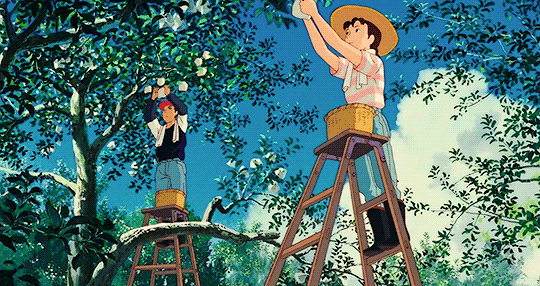
Hiya!! 💕
It's so cool that you're a computer science student, and with that, you have plenty of options for personal projects that can help with learning more from what they teach you at college. I don't have any experience being a university student however 😅
Someone asked me a very similar question before because I shared my projects list and they asked how I come up with project ideas - maybe this can inspire you too, here's the link to the post [LINK]
However, I'll be happy to share some ideas with you right now. Just a heads up: you can alter the projects to your own specific interests or goals in mind. Though it's a personal project meaning not an assignment from school, you can always personalise it to yourself as well! Also, I don't know the level you are, e.g. beginner or you're pretty confident in programming, if the project sounds hard, try to simplify it down - no need to go overboard!!

But here is the list I came up with (some are from my own list):
Personal Finance Tracker
A web app that tracks personal finances by integrating with bank APIs. You can use Python with Flask for the backend and React for the frontend. I think this would be great for learning how to work with APIs and how to build web applications 🏦
Online Food Ordering System
A web app that allows users to order food from a restaurant's menu. You can use PHP with Laravel for the backend and Vue.js for the frontend. This helps you learn how to work with databases (a key skill I believe) and how to build interactive user interfaces 🙌🏾
Movie Recommendation System
I see a lot of developers make this on Twitter and YouTube. It's a machine-learning project that recommends movies to users based on their past viewing habits. You can use Python with Pandas, Scikit-learn, and TensorFlow for the machine learning algorithms. Obviously, this helps you learn about how to build machine-learning models, and how to use libraries for data manipulation and analysis 📊
Image Recognition App
This is more geared towards app development if you're interested! It's an Android app that uses image recognition to identify objects in a photo. You can use Java or Kotlin for the Android development and TensorFlow for machine learning algorithms. Learning how to work with image recognition and how to build mobile applications - which is super cool 👀
Social Media Platform
(I really want to attempt this one soon) A web app that allows users to post, share, and interact with each other's content. Come up with a cool name for it! You can use Ruby on Rails for the backend and React for the frontend. This project would be great for learning how to build full-stack web applications (a plus cause that's a trend that companies are looking for in developers) and how to work with user authentication and authorization (another plus)! 🎭
Text-Based Adventure Game
If you're interested in game developments, you could make a simple game where users make choices and navigate through a story by typing text commands. You can use Python for the game logic and a library like Pygame for the graphics. This project would be great for learning how to build games and how to work with input/output. 🎮
Weather App
Pretty simple project - I did this for my apprenticeship and coding night classes! It's a web app that displays weather information for a user's location. You can use Node.js with Express for the backend and React for the frontend. Working with APIs again, how to handle asynchronous programming, and how to build responsive user interfaces! 🌈
Online Quiz Game
A web app that allows users to take quizzes and compete with other players. You could personalise it to a module you're studying right now - making a whole quiz application for it will definitely help you study! You can use PHP with Laravel for the backend and Vue.js for the frontend. You get to work with databases, build real-time applications, and maybe work with user authentication. 🧮
Chatbot
(My favourite, I'm currently planning for this one!) A chatbot that can answer user questions and provide information. You can use Python with Flask for the backend and a natural language processing library like NLTK for the chatbot logic. If you want to mauke it more beginner friendly, you could use HTML, CSS and JavaScript and have hard-coded answers set, maybe use a bunch of APIs for the answers etc! This project would be great because you get to learn how to build chatbots, and how to work with natural language processing - if you go that far! 🤖

Another place I get inspiration for more web frontend dev projects is on Behance and Pinterest - on Pinterest search for like "Web design" or "[Specific project] web design e.g. shopping web design" and I get inspiration from a bunch of pins I put together! Maybe try that out!
I hope this helps and good luck with your project!

#my asks#resources#programming#coding#studying#codeblr#progblr#studyblr#comp sci#computer science#projects ideas#coding projects#coding study#cs studyblr#cs academia
178 notes
·
View notes
Text
Blockchain Payments: The Game Changer in the Finance Industry
The finance industry has experienced a remarkable transformation over the past few years, with blockchain payments emerging as one of the most groundbreaking innovations. As businesses and individuals increasingly seek secure, transparent, and efficient transaction methods, blockchain technology has positioned itself as a powerful solution that challenges traditional payment systems.
Understanding Blockchain Payments
At its core, blockchain payments utilize decentralized ledger technology (DLT) to facilitate transactions without intermediaries such as banks. Unlike conventional payment systems, which rely on centralized institutions, blockchain operates through a distributed network of nodes that validate and record transactions in an immutable ledger. This decentralized approach ensures greater transparency, security, and efficiency in financial transactions.
Key Benefits of Blockchain Payments
1. Security and Transparency
Blockchain transactions are encrypted and recorded on an immutable ledger, making them highly secure and tamper-proof. The decentralized nature of blockchain ensures that no single entity can alter transaction records, increasing transparency and reducing the risk of fraud.
2. Lower Transaction Costs
Traditional payment methods often involve intermediaries such as banks and payment processors, which charge significant fees for transaction processing. Blockchain payments eliminate the need for intermediaries, resulting in lower transaction costs for businesses and consumers.
3. Faster Cross-Border Transactions
International transactions using traditional banking systems can take days to settle due to multiple intermediaries and regulatory approvals. Blockchain payments, on the other hand, enable near-instant cross-border transactions, enhancing financial inclusivity and reducing delays.
4. Enhanced Accessibility
Blockchain payments provide financial services to individuals and businesses without requiring a traditional bank account. This feature is particularly beneficial for underbanked populations, allowing them to participate in the global economy.

Real-World Applications of Blockchain Payments
E-Commerce and Retail: Merchants are integrating blockchain payment systems to accept cryptocurrencies, offering customers an alternative and secure payment method.
Remittances: Migrant workers can send money to their families without high remittance fees, ensuring more money reaches the recipients.
Supply Chain Management: Blockchain ensures secure and transparent payments between suppliers, manufacturers, and distributors.
Decentralized Finance (DeFi): DeFi platforms leverage blockchain payments for lending, borrowing, and yield farming, providing users with financial services without traditional banks.
How Resmic is Revolutionizing Blockchain Payments?
Resmic is at the forefront of enabling seamless cryptocurrency transactions, empowering businesses to embrace blockchain payments effortlessly. The platform provides a secure and user-friendly payment infrastructure, allowing businesses to accept multiple cryptocurrencies while ensuring compliance with regulatory requirements.
Key Features of Resmic:
Multi-Currency Support: Accepts various cryptocurrencies, enhancing customer flexibility.
Fast Settlements: Near-instant transactions for efficient cash flow management.
Secure Transactions: Robust encryption and decentralized validation for enhanced security.
Seamless Integration: Easy API integration with existing payment systems and e-commerce platforms.
Embracing the Future of Finance
Blockchain payments are reshaping the financial landscape, offering businesses and individuals a more efficient and secure way to transfer value globally. As adoption continues to grow, platforms like Resmic play a crucial role in facilitating this transition. By leveraging blockchain technology, businesses can stay ahead of the curve and unlock new opportunities in the digital economy.
2 notes
·
View notes
Text
Like a venomous puss moth emerging from its hard cocoon, the social network formerly known as Twitter has fully metamorphosed into X.com.
Various elements of Twitter had already embraced the rebranding, and the company has been using X.com links since early April. But now the domain has flipped over entirely, marking the end of a tumultuous transition period—and erasing the last vestiges of the bird app.
“We are letting you know that we are changing our URL, but your privacy and data protection settings remain the same,” reads a message at the bottom of the X login and home pages.
The switchover has been a long time coming. X owner Elon Musk announced the shift from Twitter to X last July, a few months after he officially acquired the company. But the billionaire has for decades harbored a dream of creating an “everything app” by that name, and Twitter is his vessel.
“The Twitter name made sense when it was just 140-character messages going back and forth—like birds tweeting—but now you can post almost anything, including several hours of video,” Musk wrote on the newly redubbed X last summer. “In the months to come, we will add comprehensive communications and the ability to conduct your entire financial world. The Twitter name does not make sense in that context, so we must bid adieu to the bird.”
Twitter under Musk has indeed added video and voice calls to its roster of features. It has also replatformed conspiracy theorists like Alex Jones, fostered a welcoming environment for porn spam accounts, made an absolute hash out of verification, introduced a monetization system that encourages rampant engagement farming, gutted its trust and safety team, allowed a surge in hate speech on the platform, designated NPR as “US state-affiliated media,” removed news headlines entirely and then reintroduced them in a weird spot, kneecapped a bunch of fun bots and third-party apps by introducing wildly expensive API changes while giving blue-check verification to AI-generated chum, pivoted to video, introduced an AI model that will help you do crimes, and overseen a decline in usage of more than 20 percent in the US, according to app analytics firm SensorTower.
The “entire financial world” part remains a work in progress.
A sentimentalist may bemoan the death of Twitter, which for all its faults always had a capacity to delight and surprise. But remember that this transformation was inevitable. Musk first owned X.com in 1999, when he cofounded an online bank by that name; it would eventually merge with a competitor and become PayPal. He bought X.com back from PayPal in 2017, tweeting that it had “great sentimental value.” And he has seen Twitter as an opportunity to create X on Earth since before the acquisition was even completed, according to Musk biographer Walter Isaacson.
“In the days leading up to his takeover of Twitter at the end of October 2022, Musk’s moods fluctuated wildly,” Isaacson wrote in Elon Musk. “He said that he would turn it into the combination of financial platform and social network he had envisioned 24 years earlier for X.com, and he added that he planned to rebrand it with that name, which he loved.”
To put an even finer point on it, Musk’s tweet today announcing that “all core systems are now on X.com” featured the logo of the company he founded 25 years ago.
While X may never become the everything app of Musk’s dreams, it’s undeniably and indelibly a different place than the one he bought. Which in some ways makes this final transition all the more palatable. Whatever Elon Musk’s platform has become, it’s certainly not Twitter. Call it whatever you want.
9 notes
·
View notes
Text
Why Troop Messenger is the Best Alternative to Discord
In today’s fast-paced world, effective communication and collaboration are essential for teams to succeed. While Discord has gained popularity for casual and gaming communities, many businesses and organizations need a more secure and feature-rich platform. Troop Messenger is the ultimate solution for those looking for a powerful and secure Discord alternatives. Here’s why Troop Messenger stands out as one of the best alternatives to Discord.
Unparalleled Security
One of Troop Messenger’s key strengths is its commitment to security. Unlike Discord, which primarily caters to casual users, Troop Messenger offers enterprise-grade security features like end-to-end encryption, data retention policies, and role-based access control. These ensure that your business communication remains private and protected from unauthorized access.
Versatile Deployment Options
Troop Messenger provides flexibility with its multiple deployment options. Businesses can choose between SaaS (cloud-based), on-premise, or self-hosted setups, unlike Discord, which is solely cloud-based. This flexibility ensures that organizations in sensitive sectors like defense, government, and BFSI (Banking, Financial Services, and Insurance) can maintain full control over their data.
Rich Collaboration Features
Troop Messenger offers a comprehensive suite of collaboration tools that outshine Discord. Features include:
One-on-One and Group Messaging: Send instant messages to individuals or groups with ease.
Audio and Video Calls: Conduct high-quality calls for effective remote communication.
Screen Sharing: Share your screen in real time to enhance collaboration.
File Sharing: Send large files securely and without hassle.
Burnout Chat: A unique feature for self-destructing messages, ensuring sensitive information remains confidential.
Seamless User Experience
While Discord is user-friendly, it often feels cluttered and overwhelming for professional users. Troop Messenger’s intuitive interface is designed specifically for productivity and efficiency. Its clean layout and customizable features make it ideal for teams of all sizes.
Advanced Integration Capabilities
Troop Messenger integrates effortlessly with a wide range of tools and platforms, such as Google Drive, Dropbox, and APIs for custom integrations. This makes it a versatile choice for businesses that rely on multiple tools to streamline their workflows.
Designed for Business Communication
Unlike Discord, which was originally created for gaming communities, Troop Messenger is purpose-built for professional communication. It meets the unique needs of industries such as:
Government Agencies: With its secure on-premise deployment.
BFSI Sector: With robust compliance features and data encryption.
Defense Organizations: Offering secure and private communication channels.
Affordable and Transparent Pricing
Troop Messenger offers competitive and transparent pricing plans that cater to businesses of all sizes. Unlike Discord, which has limitations on premium features, Troop Messenger’s plans include all essential features without hidden costs. The value it provides far outweighs its cost, making it an excellent investment for organizations.
Why Troop Messenger is Better than Discord
If you’re looking for an alternative to Discord, Troop Messenger is the best choice for several reasons:
Enhanced Security: Ideal for businesses that prioritize data privacy.
Professional Features: Tailored for corporate communication, unlike Discord’s gaming-focused features.
Flexible Deployment: Options for SaaS, on-premise, and self-hosted setups.
Scalable: Suitable for teams and organizations of all sizes.
Industry-Specific Use Cases: Perfect for government, defense, NGOs, and private sectors.
Conclusion
While Discord is a popular platform for casual communication, Troop Messenger goes above and beyond to meet the needs of businesses and organizations. Its robust security, advanced features, and professional focus make it the ultimate Discord alternative for teams seeking a secure and reliable collaboration tool. Whether you’re a small business or a large enterprise, Troop Messenger can transform how your team communicates and collaborates, ensuring productivity and success.
If you’re ready to elevate your team’s communication, make the switch to Troop Messenger today!
#alternative#technology#software#collaboration#communicataion#discord alternative#discord alternatives#alternative to discord#alternatives of discord#team collaboration#communation tool
2 notes
·
View notes
Text
Ashish Nagar, CEO & Founder of Level AI – Interview Series
New Post has been published on https://thedigitalinsider.com/ashish-nagar-ceo-founder-of-level-ai-interview-series/
Ashish Nagar, CEO & Founder of Level AI – Interview Series
Ashish Nagar is the CEO and founder of Level AI, taking his experience at Amazon on the Alexa team to use artificial intelligence to transform contact center operations. With a strong background in technology and entrepreneurship, Ashish has been instrumental in driving the company’s mission to enhance the efficiency and effectiveness of customer service interactions through advanced AI solutions. Under his leadership, Level AI has become a key player in the AI-driven contact center space, known for its cutting-edge products and superior implementation of artificial intelligence.
What inspired you to leave Amazon and start Level AI? Can you share the specific pain points in customer service that you aimed to address with your technology?
My background is building products at the intersection of technology and business. Although I have an undergrad degree in Applied Physics, my work has consistently focused on product roles and setting up, launching, and building new businesses. My passion for technology and business led me to AI.
I started working in AI in 2014, when we were building a next-generation mobile search company called Rel C, which was similar to what Perplexity AI is today. That experience sparked my journey into AI software, and eventually, that company was acquired by Amazon. At Amazon, I was a product leader on the Alexa team, continuously seeking opportunities to tackle more complex AI problems.
In my last year at Amazon, in 2018,I worked on a project we referred to as the “Star Trek computer,” inspired by the famous sci-fi franchise. The goal was to develop a computer that could understand and respond to any question you asked it. This project became known as the Alexa Prize, aiming to enable anyone to hold a 20-minute conversation with Alexa on any social topic. I led a team of about 10 scientists, and we launched this as a worldwide AI challenge. I worked closely with leading minds from institutions like MIT, CMU, Stanford, and Oxford. One thing became clear: at that time, no one could fully solve the problem.
Even then, I could sense a wave of innovation coming that would make this possible. Fast forward to 2024, and technologies like ChatGPT are now doing much of what we envisioned. There were rapid advancements in natural language processing with companies like Amazon, Google, OpenAI, and Microsoft building large models and the underlying infrastructure. But they were not necessarily tackling end-to-end workflows. We recognized this gap and wanted to address it.
Our first product wasn’t a customer service solution; it was a voice assistant for frontline workers, such as technicians and retail store employees. We raised $2 million in seed funding and showed the product to potential customers. They overwhelmingly requested that we adapt the technology for contact centers, where they already had voice and data streams but lacked the modern generative AI architecture. This led us to realize that existing companies in this space were stuck in the past, grappling with the classic innovator’s dilemma of whether to overhaul their legacy systems or build something new. We started from a blank slate and built the first native large language model (LLM) customer experience intelligence and service automation platform.
My deep interest in the complexities of human language and how challenging it is to solve these problems from a computer engineering perspective, played a significant role in our approach. AI’s ability to understand human speech is crucial, particularly for the contact center industry. For example, using Siri often reveals how difficult it is for AI to understand intent and context in human language. Even simple queries can trip up AI, which struggles to interpret what you’re asking.
AI struggles with understanding intent, maintaining context over long conversations, and possessing relevant knowledge of the world. Even ChatGPT has limitations in these areas. For instance, it might not know the latest news or understand shifting topics within a conversation. These challenges are directly relevant to customer service, where conversations often involve multiple topics and require the AI to understand specific, domain-related knowledge. We’re addressing these challenges in our platform, which is designed to handle the complexities of human language in a customer service environment.
Level AI’s NLU technology goes beyond basic keyword matching. Can you explain how your AI understands deeper customer intent and the benefits this brings to customer service? How does Level AI ensure the accuracy and reliability of its AI systems, especially in understanding nuanced customer interactions?
We have six or seven different AI pipelines tailored to specific tasks, depending on the job at hand. For example, one workflow might involve identifying call drivers and understanding the issues customers have with a product or service, which we call the “voice of the customer.” Another could be the automated scoring of quality scorecards to evaluate agent performance. Each workflow or service has its own AI pipeline, but the underlying technology remains the same.
To draw an analogy, the technology we use is based on LLMs similar to the technology behind ChatGPT and other generative AI tools. However, we use customer service-specific LLMs that we have trained in-house for these specialized workflows. This allows us to achieve over 85% accuracy within just a few days of onboarding new customers, resulting in faster time to value, minimal professional services, and unmatched accuracy, security, and trust.
Our models have deep, specific expertise in customer service. The old paradigm involved analyzing conversations by picking out keywords or phrases like “cancel my account” or “I’m not happy.” But our solution doesn’t rely on capturing all possible variations of phrases. Instead, it applies AI to understand the intent behind the question, making it much quicker and more efficient.
For example, if someone says, “I want to cancel my account,” there are countless ways they might express that, like “I’m done with you guys” or “I’m moving on to someone else.” Our AI understands the question’s intent and ties it back to the context, which is why our software is faster and more accurate.
A helpful analogy is that old AI was like a rule book—you’d build these rigid rule books, with if-then-else statements, which were inflexible and constantly needed maintenance. The new AI, on the other hand, is like a dynamic brain or a learning system. With just a few pointers, it dynamically learns context and intent, continually improving on the fly. A rule book has a limited scope and breaks easily when something doesn’t fit the predefined rules, while a dynamic learning system keeps expanding, growing, and has a much broader impact.
A great example from a customer perspective is a large ecommerce brand. They have thousands of products, and it’s impossible to keep up with constant updates. Our AI, however, can understand the context, like whether you’re talking about a specific couch, without needing to constantly update a scorecard or rubric with every new product.
What are the key challenges in integrating Level AI’s technology with existing customer service systems, and how do you address them?
Level AI is a customer experience intelligence and service automation platform. As such, we integrate with most CX software in the industry, whether it’s a CRM, CCaaS, survey, or tooling solution. This makes us the central hub, collecting data from all these sources and serving as the intelligence layer on top.
However, the challenge is that some of these systems are based on non-cloud, on-premise technology, or even cloud technology that lacks APIs or clean data integrations. We work closely with our customers to address this, though 80% of our integrations are now cloud-based or API-native, allowing us to integrate quickly.
How does Level AI provide real-time intelligence and actionable insights for customer service agents? Can you share some examples of how this has improved customer interactions?
There are three kinds of real-time intelligence and actionable insights we provide our customers:
Automation of Manual Workflows: Service reps often have limited time (6 to 9 minutes) and multiple manual tasks. Level AI automates tedious tasks like note-taking during and after conversations, generating customized summaries for each customer. This has saved our customers 10 to 25% in call handling time, leading to more efficiency.
CX Copilot for Service Reps: Service reps face high churn and onboarding challenges. Imagine being dropped into a contact center without knowing the company’s policies. Level AI acts as an expert AI sitting beside the rep, listening to conversations, and offering real-time guidance. This includes handling objections, providing knowledge, and offering smart transcription. This capability has helped our customers onboard and train service reps 30 to 50% faster.
Manager Copilot: This unique feature gives managers real-time visibility into how their team is performing. Level AI provides second-by-second insights into conversations, allowing managers to intervene, detect sentiment and intent, and support reps in real-time. This has improved agent productivity by 10 to 15% and increased agent satisfaction, which is crucial for reducing costs. For example, if a customer starts cursing at a rep, the system flags it, and the manager can either take over the call or whisper guidance to the rep. This kind of real-time intervention would be impossible without this technology.
Can you elaborate on how Level AI’s sentiment analysis works and how it helps agents respond more effectively to customers?
Our sentiment analysis detects seven different emotions, ranging from extreme frustration to elation, allowing us to measure varying degrees of emotions that contribute to our overall sentiment score. This analysis considers both the spoken words and the tonality of the conversation. However, we’ve found through our experiments that the spoken word plays a much more significant role than tone. You can say the meanest things in a flat tone or very nice things in a strange tone.
We provide a sentiment score on a scale from 1 to 10, with 1 indicating very negative sentiment and 10 indicating a highly positive sentiment. We analyze 100% of our customers’ conversations, offering a deep insight into customer interactions.
Contextual understanding is also critical. For example, if a call starts with very negative sentiment but ends positively, even if 80% of the call was negative, the overall interaction is considered positive. This is because the customer started upset, the agent resolved the issue, and the customer left satisfied. On the other hand, if the call begins positively but ends negatively, that’s a different story, despite the fact that 80% of the call might have been positive.
This analysis helps both the rep and the manager identify areas for training, focusing on actions that correlate with positive sentiment, such as greeting the customer, acknowledging their concerns, and showing empathy—elements that are crucial to successful interactions.
How does Level AI address data privacy and security concerns, especially given the sensitive nature of customer interactions?
From day one, we have prioritized security and privacy. We’ve built our system with enterprise-level security and privacy as core principles. We don’t outsource any of our generative AI capabilities to third-party vendors. Everything is developed in-house, allowing us to train customer-specific AI models without sharing data outside our environment. We also offer extensive customization, enabling customers to have their own AI models without any data sharing across different parts of our data pipeline.
To address a current industry concern, our data is not used by external models for training. We don’t allow our models to be influenced by AI-generated data from other sources. This approach prevents the issues some AI models are facing, where being trained on AI-generated data causes them to lose accuracy. At Level AI, everything is first-party, and we don’t share or pull data externally.
With the recent $39.4 million Series C funding, what are your plans for expanding Level AI’s platform and reaching new customer segments?
The Series C investment will fuel our strategic growth and innovation initiatives in critical areas, including advancing product development, engineering enhancements, and rigorous research and development efforts. We aim to recruit top-tier talent across all levels of the organization, enabling us to continue pioneering industry-leading technologies that surpass client expectations and meet dynamic market demands.
How do you see the role of AI in transforming customer service over the next decade?
While the general focus is often on the automation aspect—predicting a future where bots handle all customer service—our view is more nuanced. The extent of automation varies by vertical. For example, in banking or finance, automation might be lower, while in other sectors, it could be higher. On average, we believe that achieving more than 40% automation across all verticals is challenging. This is because service reps do more than just answer questions—they act as troubleshooters, sales advisors, and more, roles that can’t be fully replicated by AI.
There is also significant potential in workflow automation, which Level AI focuses on. This includes back-office tasks like quality assurance, ticket triaging, and screen monitoring. Here, automation can exceed 80% using generative AI. Intelligence and data insights are crucial. We are unique in using generative AI to gain insights from unstructured data. This approach can vastly improve the quality of insights, reducing the need for professional services by 90% and accelerating time to value by 90%.
Another important consideration is whether the face of your organization should be a bot or a person. Beyond the basic functions they perform, a human connection with your customers is crucial. Our approach is to remove the excess tasks from a person’s workload, allowing them to focus on meaningful interactions.
We believe that humans are best suited for direct communication and should continue to be in that role. However, they’re not ideal for tasks like note-taking, transcribing interactions, or screen recording. By handling these tasks for them, we free up their time to engage with customers more effectively.
Thank you for the great interview, readers who wish to learn more should visit Level AI.
#2024#agent#agents#ai#AI models#AI systems#ai tools#alexa#Amazon#Analysis#API#APIs#approach#architecture#artificial#Artificial Intelligence#automation#automation platform#background#banking#book#Books#bot#bots#Brain#Building#Business#CEO#challenge#chatGPT
0 notes
Text
#kyc services#kyc provider#kyc platform providers#kyc solutions#kyc software#kyc platform#kyc company#KYC UK#kyc solution#kyc api#banks#finance#kyc companies#gaming#business#uk
1 note
·
View note
Text
#API Banking India#Connected Banking#bank api provider#banking api provider#banking api provider india#banking api providers india#banking api providers#api banking solutions company#banking api india#open banking api india#api banking india#open banking api providers#api banking solutions#open banking in india#api banking platform#api banking#api service provider#api banking services#open banking api#open banking api platform
0 notes
Text
0 notes